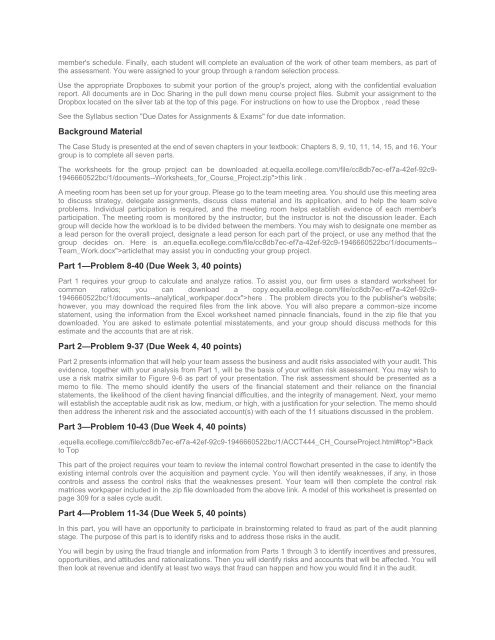ACCT 444 DeVry Entire Course
Create successful ePaper yourself
Turn your PDF publications into a flip-book with our unique Google optimized e-Paper software.
member's schedule. Finally, each student will complete an evaluation of the work of other team members, as part of<br />
the assessment. You were assigned to your group through a random selection process.<br />
Use the appropriate Dropboxes to submit your portion of the group's project, along with the confidential evaluation<br />
report. All documents are in Doc Sharing in the pull down menu course project files. Submit your assignment to the<br />
Dropbox located on the silver tab at the top of this page. For instructions on how to use the Dropbox , read these<br />
See the Syllabus section "Due Dates for Assignments & Exams" for due date information.<br />
Background Material<br />
The Case Study is presented at the end of seven chapters in your textbook: Chapters 8, 9, 10, 11, 14, 15, and 16. Your<br />
group is to complete all seven parts.<br />
The worksheets for the group project can be downloaded at.equella.ecollege.com/file/cc8db7ec-ef7a-42ef-92c9-<br />
1946660522bc/1/documents--Worksheets_for_<strong>Course</strong>_Project.zip">this link .<br />
A meeting room has been set up for your group. Please go to the team meeting area. You should use this meeting area<br />
to discuss strategy, delegate assignments, discuss class material and its application, and to help the team solve<br />
problems. Individual participation is required, and the meeting room helps establish evidence of each member's<br />
participation. The meeting room is monitored by the instructor, but the instructor is not the discussion leader. Each<br />
group will decide how the workload is to be divided between the members. You may wish to designate one member as<br />
a lead person for the overall project, designate a lead person for each part of the project, or use any method that the<br />
group decides on. Here is an.equella.ecollege.com/file/cc8db7ec-ef7a-42ef-92c9-1946660522bc/1/documents--<br />
Team_Work.docx">articlethat may assist you in conducting your group project.<br />
Part 1—Problem 8-40 (Due Week 3, 40 points)<br />
Part 1 requires your group to calculate and analyze ratios. To assist you, our firm uses a standard worksheet for<br />
common ratios; you can download a copy.equella.ecollege.com/file/cc8db7ec-ef7a-42ef-92c9-<br />
1946660522bc/1/documents--analytical_workpaper.docx">here . The problem directs you to the publisher's website;<br />
however, you may download the required files from the link above. You will also prepare a common-size income<br />
statement, using the information from the Excel worksheet named pinnacle financials, found in the zip file that you<br />
downloaded. You are asked to estimate potential misstatements, and your group should discuss methods for this<br />
estimate and the accounts that are at risk.<br />
Part 2—Problem 9-37 (Due Week 4, 40 points)<br />
Part 2 presents information that will help your team assess the business and audit risks associated with your audit. This<br />
evidence, together with your analysis from Part 1, will be the basis of your written risk assessment. You may wish to<br />
use a risk matrix similar to Figure 9-6 as part of your presentation. The risk assessment should be presented as a<br />
memo to file. The memo should identify the users of the financial statement and their reliance on the financial<br />
statements, the likelihood of the client having financial difficulties, and the integrity of management. Next, your memo<br />
will establish the acceptable audit risk as low, medium, or high, with a justification for your selection. The memo should<br />
then address the inherent risk and the associated account(s) with each of the 11 situations discussed in the problem.<br />
Part 3—Problem 10-43 (Due Week 4, 40 points)<br />
.equella.ecollege.com/file/cc8db7ec-ef7a-42ef-92c9-1946660522bc/1/<strong>ACCT</strong><strong>444</strong>_CH_<strong>Course</strong>Project.html#top">Back<br />
to Top<br />
This part of the project requires your team to review the internal control flowchart presented in the case to identify the<br />
existing internal controls over the acquisition and payment cycle. You will then identify weaknesses, if any, in those<br />
controls and assess the control risks that the weaknesses present. Your team will then complete the control risk<br />
matrices workpaper included in the zip file downloaded from the above link. A model of this worksheet is presented on<br />
page 309 for a sales cycle audit.<br />
Part 4—Problem 11-34 (Due Week 5, 40 points)<br />
In this part, you will have an opportunity to participate in brainstorming related to fraud as part of the audit planning<br />
stage. The purpose of this part is to identify risks and to address those risks in the audit.<br />
You will begin by using the fraud triangle and information from Parts 1 through 3 to identify incentives and pressures,<br />
opportunities, and attitudes and rationalizations. Then you will identify risks and accounts that will be affected. You will<br />
then look at revenue and identify at least two ways that fraud can happen and how you would find it in the audit.

















